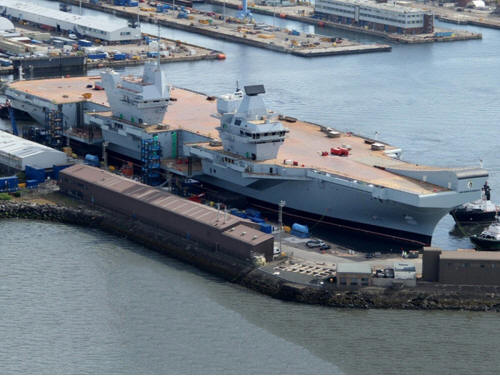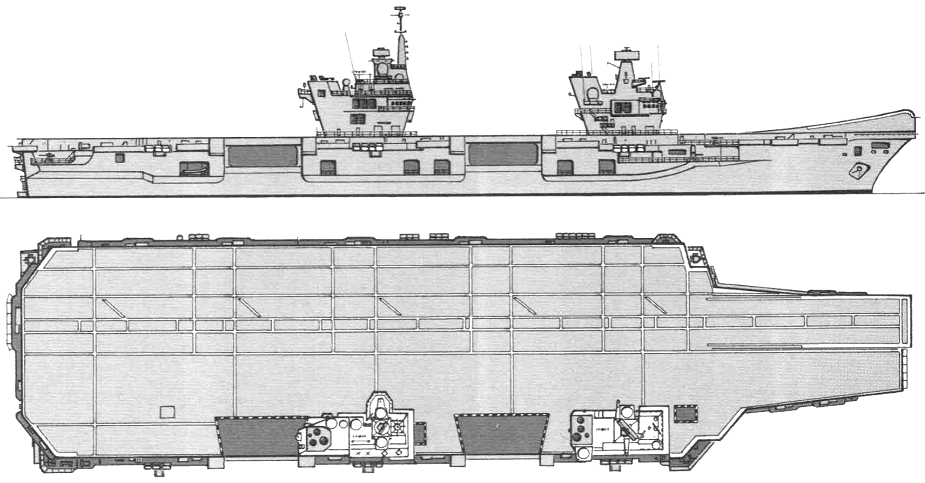
NAVYPEDIA
 Support the project with paypal
Support the project with paypal
Photo

Queen Elizabeth 2014
Ships
| Name | No | Yard No | Builder | Laid down | Launched | Comp | Fate |
|---|---|---|---|---|---|---|---|
| Queen Elizabeth | R08 | Babcock, Rosyth | 7.7.2009 | 17.7.2014 | 7.12.2017 | in service (2019) | |
| Prince of Wales | R09 | Babcock, Rosyth | 26.5.2011 | 21.12.2017 | 2019 | building (2019) |
Technical data
| Displacement standard, t | |
|---|---|
| Displacement full, t | 65500 |
| Length, m | 263.5 pp 283.0 oa |
| Breadth, m | 39.0 wl 73.0 fd |
| Draught, m | 12.0 |
| No of shafts | 2 |
| Machinery | 2 Rolls-Royce MT 30 gas turbine-generators + 4 Wärtsilä 38 diesel-generators, 4 Converteam electric motors |
| Power, h. p. | 97920 + 29910 + 24473 = 108800 |
| Max speed, kts | 27 |
| Fuel, t | gas turbine oil + diesel oil 8600t |
| Endurance, nm(kts) | 10000(15) |
| Armament | 3 x 1 - 30/75 DS-30M Mk 2, 3 x 6 - 20/76 Phalanx Mk 15 Mod. 1B, 40 aircraft (36 F-35B Lightning fighters, 4 Merlin helicopters) |
| Electronic equipment | type 997, type 1046, SPN-720, Sperry Marine radars, ECM suite, type 2170 SSTD anti-torpedo system, CMS-1 CCS |
| Complement | 1700 |
Air group
| Year | Fighters | Helicopters |
|---|---|---|
| design | 36 F-35B Lightning II | 4 Merlin AEW |
Standard scale images

Queen Elizabeth
Graphics
Aircraft facilities
Flight deck (283.9x73.0m) has 13000m² area with 6 landing spots, fighters take off from 13° ski-jump. Two 70t aircraft elevators have 400m² area each. Hangar is 7 - 9m in height, 29m in width and 163m in length and can accommodate 20 aircraft.
Project history
Hulls were assembled by Babcock at Rosyth from 5 separate blocks, built by various shipyards: Babcock, Rosyth and Appledore (Block 1, bow), BVT, Portsmouth (Block 2), BVT, Barrow-in-Furness on Tyne (Block 3), BVT, Govan (Block 4), BVT, Portsmouth (Block 5, stern). Upper hull parts were built by A & P Tyne and flight deck by Cammell Laird. Superstructures were built by BVT, Portsmouth (islands) and Babcock (sponsons).
The July 1998 Defence White Paper confirmed that two conventional carriers would be built to replace the Invincible class. The U.S. F-35 Lightning II JSF (joint strike fighter) will form the principal component of the air group, with the air wing consisting of 36 F-35B fighters and 4 helicopters. Thales was selected on 30-1-03 to design the vessel, but with BAE Systems as prime contractor. Contract for construction of both carriers signed 3.7.2008. The Aircraft Carrier Alliance is responsible for ensuring delivery of the ships and is made up of a partnership between Babcock, BAE Systems, and Thales UK.
The class's twin island design separates running of the ship from flying operations, which are run from the aft island, allowing increased visibility of flight operations. Mechanized weapon handling systems permit reduced crew size. Medical facilities include an eight-bed medical suite, dental room, and operating areas, which can be expanded as needed. Crew facilities include a cinema, fitness suites, four galleys, and four large dining areas, the largest of which can serve 960 personnel per hour. Each ship will have nine decks (including the flight deck) and 19 watertight compartments. There are rolling stabilizers. Flight deck has five multipurpose landing spots and one helicopter-only landing spot. Two aircraft elevators are fitted to starboard. The 2010 Strategic Defense Review initially called for the first ship of the class to be fitted only for helicopter operations, and the second ship, HMS Prince of Wales, to be outfitted with the EMALS electromagnetic catapult system and an airwing of convention F-35Cs, which require catapults and arresting gear. This decision was reversed during May 2012 when the Ministry of Defence announced its decision to acquire F-35B Lightning II STOVL aircraft and cancelled plans to install catapults and arresting gear in the second unit of the class. As a result of this decision, both R 08 and R 09 are built with ski jumps to facilitate rolling launch of the F-35B. Flight decks are to be treated with a special heat-resistant coating to prevent heat damage from jet blast during F-35B vertical flight operations. The ships are expected to be able to conduct campaigns of up to 150 first-day sorties or 100 sorties per day for 10 days.
Modernizations
None.
Naval service
No significant events.
 HOME
HOME FIGHTING SHIPS OF THE WORLD
FIGHTING SHIPS OF THE WORLD UNITED KINGDOM
UNITED KINGDOM AIRCRAFT CARRYING SHIPS
AIRCRAFT CARRYING SHIPS QUEEN ELIZABETH fleet aircraft carriers (2017-)
QUEEN ELIZABETH fleet aircraft carriers (2017-)
